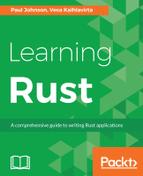The for loops are slightly different from the same construct in C-like languages. In C, the for loops consist of three things: an initialization, a stopping condition, and a stepping instruction. Rust for loops are a bit higher-level though: they are for iterating through sequences.
Let's take a simple example to start with—a loop that goes from 0 to 10 and outputs the value:
for x in 0..10
{
println!("{},", x);
}
We create a variable x that takes an element from the range (0..10), one by one, and does something with it. In Rust terminology, 0..10 is not only a variable but also an iterator, as it gives back a value from a series of elements.
This is obviously a very simple example. We can also define the iterator to work in the opposite direction. In C, you will expect something akin to for (i = 10; i > 0; --i). In Rust, we use the rev() method to reverse the iterator, as follows:
for x in (0..10).rev()
{
println!("{},", x);
}
It is worth noting that the range excludes the last number. So, for the previous example, the values outputted are 9 to 0; essentially, the program generates the output values from 0 to 10 and then outputs them in reverse.
The general syntax for the for loops is as follows:
for var in sequence
{
// do something
}
The C# equivalent for the preceding code is as follows:
foreach(var t in conditionsequence)
// do something
